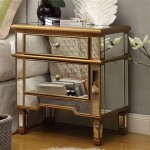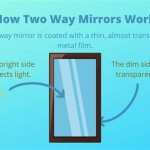How To Install A Bathroom Mirror With Lights
Installing a bathroom mirror with integrated lights can significantly enhance the functionality and aesthetic appeal of the space. This process requires careful planning and execution to ensure proper wiring, secure mounting, and a polished final result. This article outlines a step-by-step guide for installing a lighted bathroom mirror.
Preparation and Planning
Before beginning the installation, several key preparations are necessary:
- Turn off the power: Locate the circuit breaker controlling the bathroom's electrical circuits and switch it off to prevent electrical shocks.
- Gather necessary tools and materials: These may include a voltage tester, wire strippers, wire connectors, a drill with appropriate drill bits, screws, a stud finder, a level, safety glasses, and work gloves.
- Inspect the mirror and its components: Ensure all parts, including the mirror, mounting hardware, and light fixtures, are present and undamaged.
- Check existing wiring: Determine if the existing wiring is adequate for the new mirror. Some lighted mirrors require a dedicated circuit.
- Read the manufacturer's instructions: Specific installation instructions may vary depending on the mirror model. Carefully review the provided documentation before proceeding.
Mounting the Mirror
The mounting method depends on the mirror's design and weight.
- Locate wall studs: Use a stud finder to mark the location of wall studs. Mounting the mirror directly to studs provides the most secure installation.
- Mark mounting points: Use a level and the manufacturer's template (if provided) to accurately mark the desired mirror position and mounting points on the wall.
- Pre-drill holes (if necessary): If mounting to studs, pre-drilling pilot holes can prevent wood splitting. Use the appropriate drill bit size for the mounting screws.
- Install mounting hardware: Securely attach the mounting brackets or clips to the wall, ensuring they are level and firmly anchored.
Electrical Connections
Connecting the mirror's electrical components requires careful attention to safety and proper wiring techniques.
- Double-check power disconnection: Use a voltage tester to confirm that the power is off at the junction box before proceeding with any wiring.
- Connect the wires: Follow the manufacturer's instructions to connect the mirror's wiring to the existing electrical wires in the junction box. Typically, this involves connecting black wires to black (hot), white wires to white (neutral), and green or bare copper wires to ground.
- Secure wire connections: Use appropriate wire connectors (wire nuts) to securely join the wires. Ensure the connections are tight and properly insulated.
- Tuck wires neatly into the junction box: Carefully fold and tuck the wires back into the junction box to prevent interference with the mirror installation.
Securing the Mirror
Once the electrical connections are complete, the mirror can be secured to the mounting hardware.
- Carefully hang the mirror: Align the mirror with the mounting hardware and gently hang it in place.
- Secure the mirror: Depending on the mounting system, this may involve tightening screws, locking clips, or other mechanisms. Refer to the manufacturer’s instructions for specific guidance.
- Check mirror stability: Gently tug on the mirror to ensure it is securely mounted and does not wobble.
Final Steps and Testing
After securing the mirror, the final steps involve completing the installation and testing the lights.
- Install any remaining components: Some mirrors may have decorative covers or trim pieces that need to be installed after the mirror is mounted.
- Restore power: Turn the circuit breaker back on to restore power to the bathroom circuit.
- Test the lights: Switch on the mirror's lights to verify they are functioning correctly.
- Inspect for any issues: Check for any loose connections, gaps, or other problems. Address any issues immediately.
Wall Anchors (Alternative Mounting Method)
If mounting directly to studs is not feasible, wall anchors can provide a secure alternative.
- Choose appropriate anchors: Select wall anchors that are rated for the weight of the mirror. Toggle bolts or heavy-duty plastic anchors are common choices.
- Drill pilot holes: Drill pilot holes of the correct size for the chosen anchors.
- Install anchors: Insert the anchors into the pilot holes and ensure they are flush with the wall surface.
- Attach mounting hardware: Secure the mounting hardware to the wall using the installed anchors.
GFCI Protection
GFCI (Ground Fault Circuit Interrupter) protection is essential for bathroom circuits.
- Verify GFCI protection: Ensure the bathroom circuit is protected by a GFCI outlet or circuit breaker.
- Test GFCI functionality: Periodically test the GFCI outlet or breaker to ensure it is working correctly.

Diy Led Mirror Installation Personal Tips And Review

2 Ways To Wire Led Bathroom Mirror Hauschenhome

How To Install A Bathroom Vanity Mirror Light

Installing An Electric Led Mirror In A Bathroom Fused Connection Unit Fcu Spur Basin Zones

Install A Recessed Vanity Mirror

How To Install Bathroom Led Mirror

How To Install An Led Mirror Bokih Bathroom

Replacing A Light Fixture On Vanity Mirror

How To Diy Vanity Mirror With Led Strip Lights

Bathroom Fan And Shaver Mirror Light Question Diynot Forums








